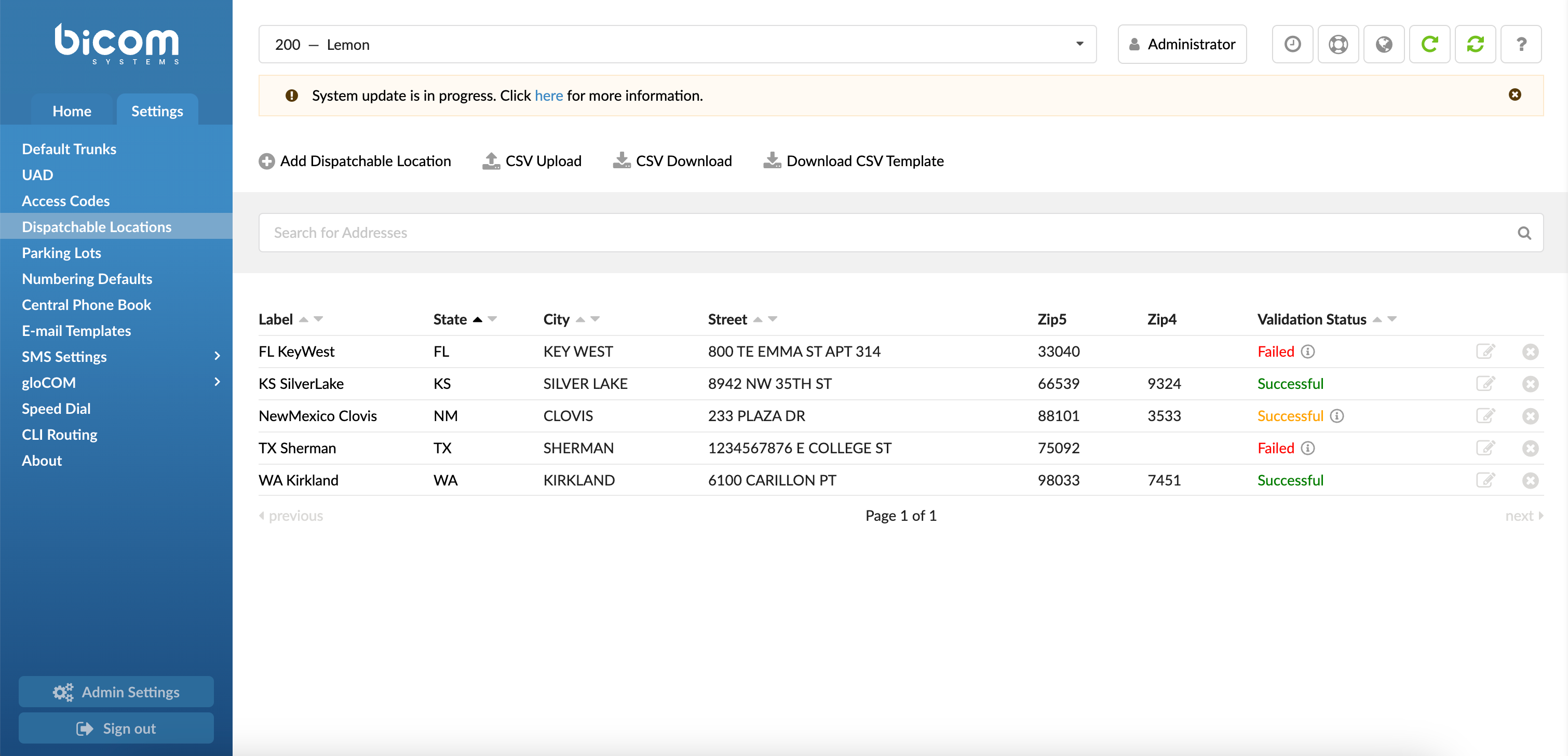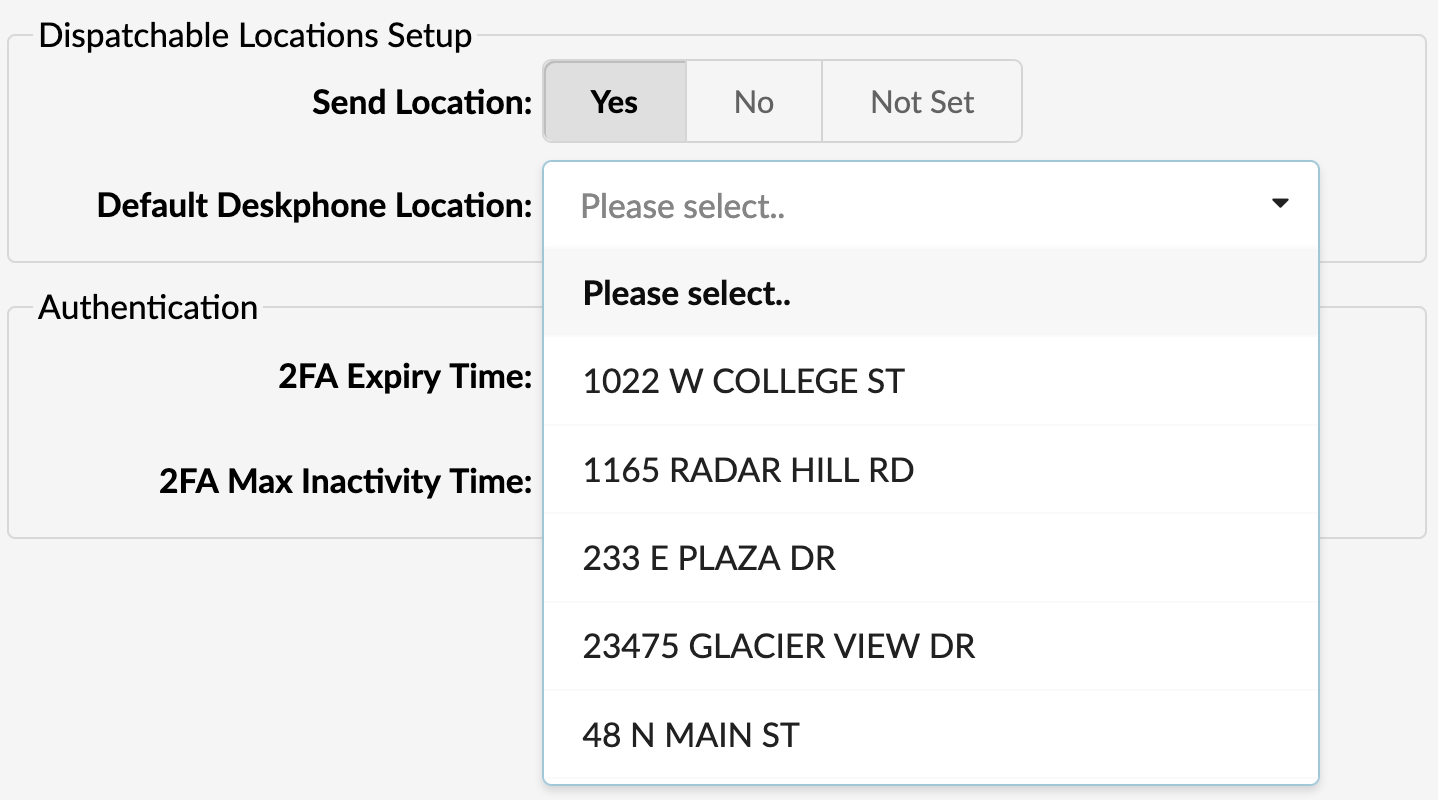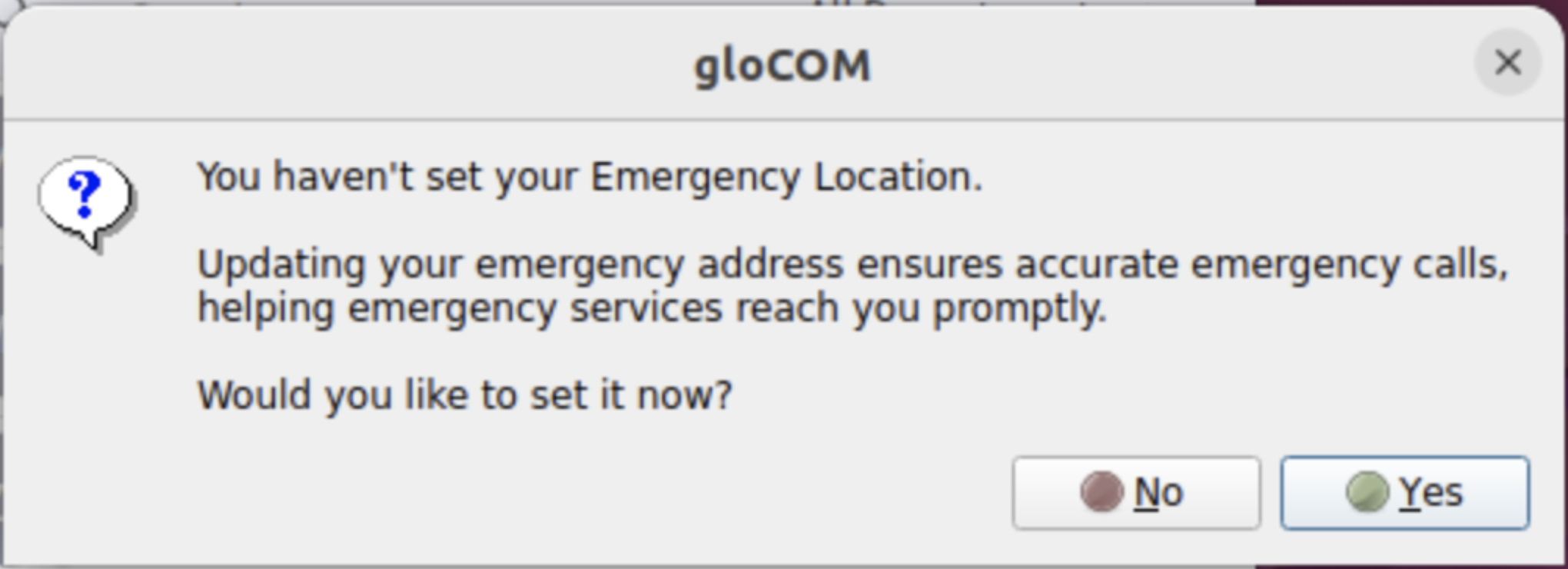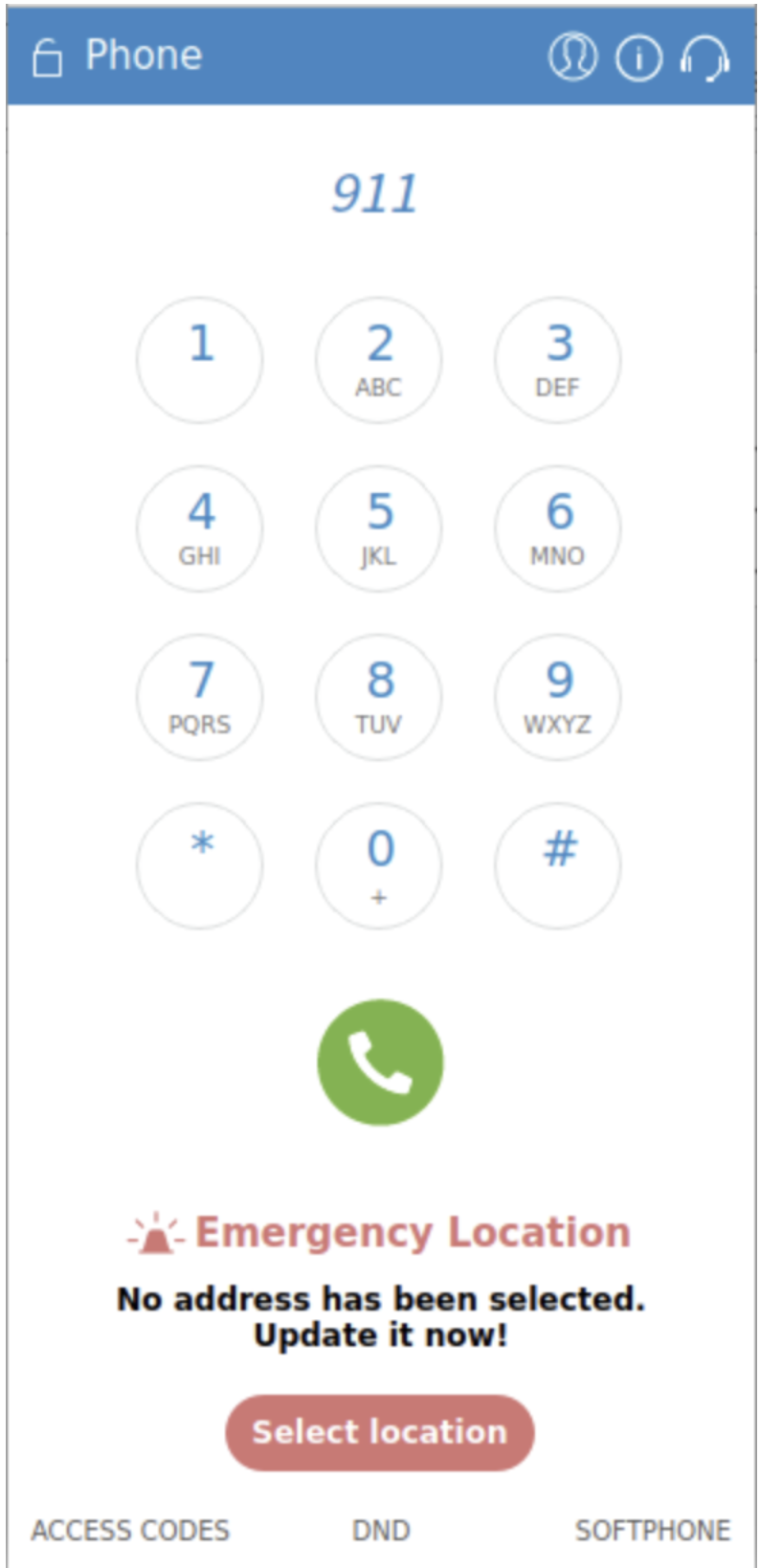¶ Ray Baum's Act Implementation in PBXware
RAY BAUM'S Act emphasizes the importance of making dispatchable location information from all 911 calls available to PSAPs, regardless of the technological platform used. The FCC states “dispatchable location means a location delivered to the public safety answering point (PSAP) with a 911 call that consists of the validated street address of the calling party, plus additional information such as suite, apartment or similar information.”*
To comply with Ray Baum's Act, PBXware must send location information inside the SIP message when an emergency number is dialed. Right now we have the “Location” field on the PBXware Extensions page where administrators can enter a Geolocation URL for each MAC address. Then, when a call is made, the User Agent's MAC address is looked up and its Location URL is sent via Geolocation SIP Header. This solves the issue with fixed devices, but does not solve the issue with laptops or mobile phones which have softphone applications installed (gloCOM). The location of users using gloCOM can change any time so a fixed Geolocation URL does not work here.
¶ Dispatchable Locations Management Interface
- Enable Dispatchable Locations

In order to enable this feature, the option Send Location under tenant configuration must be enabled. This option is available on Master Tenant too and it uses the familiar hierarchy when it comes to the PBXware levels (Tenant, Master Tenant). If enabled on the Master Tenant, 'Send location' will be enabled for ALL tenants, and a new section “Dispatchable Locations” will be visible and available for ALL tenants. 'Send location' on a tenant level holds the priority so if 'Send location' is set to NO for a specific tenant, that will override the 'Send location' setup on the Master tenant level. Same goes if the 'Send location' is set to Yes on a Tenant level and NO on a Master tenant level, the setup from the Tenant will always be used for that tenant. If enabled, the Dispatchable Locations menu item can be found per each Tenant under the Settings tab.

The Dispatchable Locations page contains all locations with their parameters, which are used for validation. In order to prevent errors when adding addresses, each address is validated through the USPS (United States Postal Service) API and only addresses that have been successfully validated can be used when making emergency calls. If the dispatchable location is not validated successfully, an info icon will be displayed next to the Failed status, with additional information why the validation is marked as failed.
- Add/Edit Dispatchable Location

This page is divided into three sections:
General - holds all the required fields users need to populate
gloCOM permissions - used for assigning the permissions for use of specific location(s) to individual gloCOM users (whether it is done per tenant, departments or individual gloCOM extension).
Deskphone Users Configuration - used for assigning UAD MAC addresses that will be used with that specific location.
¶ General
- Label (Required)
Label field is used for easier organization and filtering purposes. (i.e. Main Office)
- State (Required)
The state the dispatchable location is located in. Select the state from the dropdown menu.
- City (Required)
Name of the city the dispatchable location is located in. A correct city name located in the selected state must be entered.
- House Number (Required)
The exact house number for the location
- Street Name (Required)
A street name in which the dispatchable location is in. A valid street name must be entered. Once the entry is validated, it will be formatted in the proper way.
- Street Suffix (Optional)
A street suffix for the address dispatchable location is in. (i.e. street, avenue, lane, drive etc.)
- Leading Street Direction Type (Optional) (7.6)
The type of the leading street direction. This is an optional field, and from the dropdown users can choose Pre-Directional, Post-Directional or leave it empty.
- Leading Street Direction (Optional)
The direction in which the street traffic is oriented.
- ZIP5 (Required)
The ZIP code of the area dispatchable location is in. A valid 5-digit ZIP code of the area must be entered.
- ZIP4 (Optional)
Additional 4-digit ZIP code that provides more specific location details.
NOTE: If an invalid ZIP5 or ZIP4 is entered, both will be auto-populated according to the address entered above.
- Floor (Optional)
The exact floor number the device is located on.
- Room (Optional)
The exact number or name of the room the device is located in.
¶ gloCOM Permissions
Tenant admins will be able to select which gloCOM user will be able to use each location. The following permissions can be set up:
- Everyone
Assign the location to every gloCOM user on the tenant.
If it is set to YES all gloCOM users on that tenant/server can see use that specific location.
When 'Everyone' is set to Yes, the Departments and Extensions dropdown menus are disabled. If set to NO, only the selected gloCOM extensions and departments can use this location.
- Departments
Dropdown menu where we can see all available departments on the server/tenant. Only gloCOM extensions that are part of the department that is selected here will be able to use this location.
- Extensions
Dropdown menu where we can see and select all available extensions on the specific tenant/server. Only selected extensions will be able to use and see this location..
NOTE: Setting these gloCOM permissions does not mean that the location is assigned to some specific gloCOM user, it just means that it will appear in the gloCOM App under the Emergency Locations tab and the gloCOM user is responsible for selecting the exact location.
¶ Deskphone Users Configuration
As mentioned above, Deskphone Users Configuration can be used for adding MAC addresses of UADs that will use the specific location. Adding MAC addresses means assigning that dispatchable location to the specific MAC. This means that one MAC address can only “use” one location at the time, since the deskphone can not be at two or more locations at the same time.
NOTE: If the same MAC address is added to a different location,the following warning will be displayed: “The MAC address 'XXXXXXXXXXXX' is already associated with the Dispatchable Location 'ID_Number'!”
NOTE: In order to send the selected location and match specific MAC Address, the UAD must be autoprovisioned.
Beside assigning dispatchable locations to specific MAC addresses, it is also possible to set one location per tenant level, where all deskphones will use that same address. This option can be found when editing Tenant under Dispatchable Locations Setup section:

NOTE: If the Default Deskphone Location is used and set up on the Server/Tenant, the Deskphone Users Configuration section will not be visible when adding/editing Dispatchable Location and all deskphones will be using that selected default Deskphone location.
¶ Expected result afteradding Dispatchable Locations
If everything is set up correctly the Validation Status will be displayed as Successfull

Invalid information entered will lead to the Failed Validation Status. Hover over the information icon next to the failed validation status and the popup will reveal more details on why the validation failed.

¶ Dispatchable Locations CSV options
In addition to the possibility of adding locations one by one, there is also a CSV upload option as a faster way of editing or adding new locations. There are also CSV Download and Download CSV Template options. The following screenshot shows an example of CSV file with dispatchable locations.
- CSV Upload
You can use CSV Upload to create multiple Dispatchable Location entries easily at the same time, by uploading a .csv file with all the necessary configuration details.
CSV file must follow this format:
label,state,city,house_number,direction,street_name,street_suffix,zip5,zip4,floor,room,allow_everyone,departments,extensions,mac_addresses_labels
To upload your CSV file, click the 'Browse' button, select a .csv file from your computer, click 'Open', and then click the 'CSV Upload' button.
Please note, when uploading a CSV file, all the entries currently available on the system will be deleted, so make sure you have all the necessary dispatchable locations added in the CSV file you are uploading.
NOTE: It is very important to know that due to the way data is handled when CSV upload is used, the Default Deskphone Location entries under the system settings will be removed and will have to be manually re-assigned.
¶ OSC Dispatchable Locations Management
Another way to add a new Location for a specific gloCOM user is through the OSC and the Dispatchable Locations tab, or from gloCOM App (navigate to Preferences -> Phone -> Emergency Location and click on Add Location), which will open the OSC and navigate to Dispatchable Locations.
The list of all addresses that are assigned to only this specific extension will be presented in the OSC. Other than that, the user can edit an already validated address from the OSC or add a new one.
NOTE: Add Dispatchable Location in OSC contains a general section only.

After adding a new Dispatchable Location, the validation process is the same, if the address is valid it will be marked as "Successful" and if not it will be marked "Failed".
NOTE: If in any case, this extension/glocom user shares the location with another extension or department, then that location will not be visible in the OSC.
¶ Using the specific Dispatchable Location in gloCOM
NOTE: Please be aware that this option is exclusive to the United States locality. Consequently, none of the following functionalities will be accessible if the Location on Server/Tenant is set to anything other than the United States.
Upon logging into gloCOM Desktop, the system will verify whether the Emergency Location Address has been designated. If not, an informational window will appear, presenting the message: "You haven't configured your Emergency Location." The user will have the option to click "Yes" to promptly set up the location or choose "No" to address it at a later time.

The gloCOM user will be able to select any address that is associated with that gloCOM extension, whether it is linked to that specific extension, a department to which the extension belongs or the location is permitted at the tenant level.

Floor number and Room number fields can be overridden in gloCOM for each location, by entering the new values in the designated fields. If left empty, then the values that are entered on the server side will be sent.
If no address is selected in gloCOM and the emergency call is made, another warning will be displayed advising the caller to set up the location address before making an emergency call.

NOTE: When making a call via gloCOM (deskphone mode), the location that is selected for that gloCOM extension should be sent (if selected), not the one that is associated with that deskphone’s MAC address . If the location is not selected, the PIDF-LO object will be sent with all empty location parameters.
¶ Checking if correct location is being sent
NOTE: In order to prevent calling 911, providers support a test number for this purpose. To test your 911 service, dial 933. This will take you to a recorded message that will read back to you the Caller ID that you are using and provide you with the E911 address that is setup for that DID.
Too check whether the desired location is sent, sngrep tool should be used for analyzing SIP invites. If you are not familiar with using sngrep, please refer to this sngrep HOWTO for more information on how to use it in PBXware.
After selecting the location and making an emergency call, SIP INVITE must contain an XML PIDF-LO object. Whether you are making a call via gloCOM or deskphone the PIDF-LO object should be a part of SIP INVITE. This XML is easy to read and it should encapsulate all dispatchable location’s parameters such as State, City, Street, ZIP5, ZIP4, Floor and Room. Here is the example of SIP INVITE that has PIDF-LO object attached:

NOTE: Please be aware that if the location is not selected when making an emergency call, the PIDF-LO object will be sent with all empty location parameters.